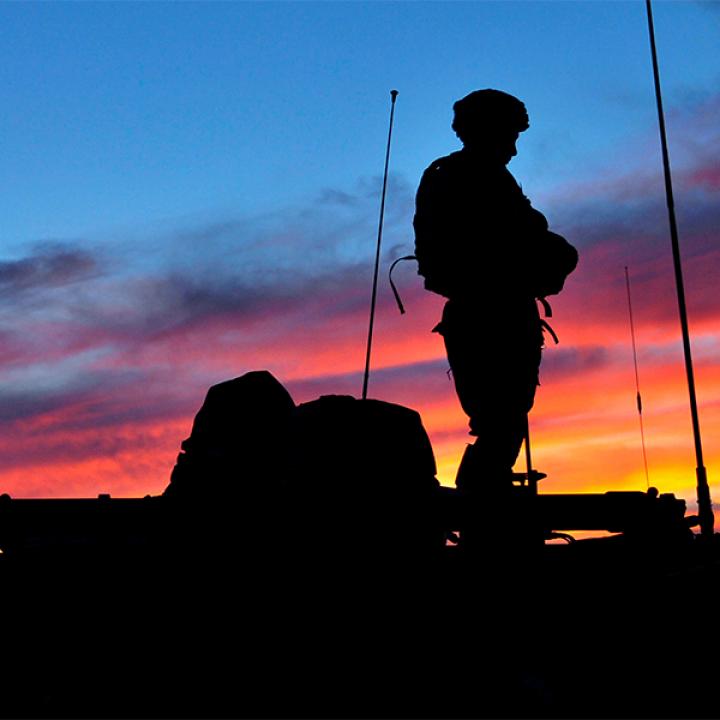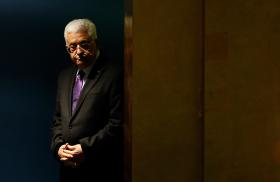
- Policy Analysis
- PolicyWatch 2639
Rethinking the U.S. Military Role in the Middle East

Three experts assess the past and future of American military involvement in the region and discuss whether it is possible to defend U.S. interests without creating open-ended quagmires.
On June 24, James Jeffrey, Michael Eisenstadt, and Gideon Rose addressed a Washington Institute Policy Forum marking the release of the new report U.S. Military Engagement in the Broader Middle East. Jeffrey is the Institute's Philip Solondz Distinguished Fellow and former U.S. ambassador to Iraq and Turkey. Eisenstadt is the Institute's Kahn Fellow and director of its Military and Security Studies Program. Rose is the editor of Foreign Affairs and served on the National Security Council staff during the Clinton administration. The following is a rapporteur's summary of their remarks.
JAMES JEFFREY
In his book How Wars End, Gideon Rose wrote that military action does not achieve much without a durable political arrangement, and this dictum certainly holds true in the Middle East. The problem lies in defining what a durable political arrangement is.
Since World War II, the United States has conducted differing levels of military operations in the region, but all in the context of promoting a liberal world order centered on an American-led collective security system. Ideally, part of this strategy was to avoid overly committing to ground combat, but the region's persistent chaos has forced America to become directly involved there time and time again, including three coalition campaigns in or against Iraq since 1990, as well as fifteen years of fighting in Afghanistan.
Part of the challenge is that the Middle East does not lend itself to a one-time fix, where an underlying security problem is addressed and then no longer an issue. Moreover, the United States tends to define durable political arrangements in a very broad, almost transcendental way that has been particularly unsuccessful in the region. Both during and after the Cold War, significant military inventions there were based on the overall strategy of containing the Soviet Union and other would-be hegemons such as Iran, Iraq, and Libya, using a structure of regional security relationships, bases, arms shipments, and assistance to local allies as a means of limiting American deployments. For the most part, this approach worked quite well, with a few exceptions such as the Iranian hostage crisis, Beirut, and Somalia. Yet issues arose when the United States made open-ended troop commitments without formulating a durable political arrangement in advance. Absent that, injecting American forces into civil-war-like situations proved fruitless, since Washington was constantly changing the political goals to correspond with what was occurring on the ground. U.S. efforts in Iraq and Afghanistan ultimately failed because locals had their own goals and motivations, and because growing casualties steadily eroded public support at home.
Yet this is not to say that the use of military force in the Middle East is inherently wrong-headed. Quite the opposite: over the past seventy years, the United States has conducted forty-one minor or major operations in the region, and most of them have succeeded militarily and helped maintain alliances. The past fifteen years have been different largely due to changing perceptions of success in the region, most notably in Iraq after 2003, in Afghanistan, and against the Islamic State and Iran. Much of the American public believes that their country is overly engaged in the Middle East, and this is a direct consequence of the government's post-September 11 decision to stop defining "durable political arrangements" as "a status quo that keeps a lid on the region's inherent turmoil." Although that decision may have been understandable at the time, it led successive administrations to pursue a doomed strategy of using military intervention in Iraq, Afghanistan, and elsewhere as lever to transform those societies and the region as a whole.
Following the latest string of unsuccessful operations that lacked a clear political endgame (e.g., Libya, Syria), the current administration seems to believe that retrenchment is the best approach, in part to facilitate a shift toward Asia. Yet retrenchment has only made the situation worse. The Middle East remains important to global security and thus American security, and the use of military force can still help manage the region's manifold dangers -- assuming such efforts are carefully managed, with goals that make sense and do not seek to transform entire societies.
MICHAEL EISENSTADT
Although the American people are exasperated with the Middle East's "forever wars," the United States has vital interests that require it to remain militarily engaged there. The region's vast oil and gas reserves are economically essential to key trade partners, and its role in proliferation and as an exporter of instability and violent extremism are ignored only at one's own peril.
Yet the United States has not dealt very effectively with the security challenges of the post-9/11 era, from transnational terrorist networks to resilient insurgencies to state building. Policymakers need to reassess how America thinks and acts militarily in the region so that they can better advance U.S. interests there. This means developing a better understanding of the region's culture and politics (i.e., the operational environment), particularly the workings of a "pre-Westphalian" state system in which Middle Eastern countries tend to meddle in each other's affairs, thereby preventing military victors from consolidating their successes.
Consequently, U.S. policymakers should have modest expectations of what military interventions in the region can achieve, abandoning "solutionism." Many Middle Eastern conflicts cannot be solved at the moment, only managed. At the same time, this dynamic works both ways, creating opportunities to roll back the achievements of U.S. adversaries.
Inadequate understanding of the operational environment has led to subpar performance in a number of areas: in its campaign against the Islamic State, wherein U.S. policies toward Syria and Iran have become a recruiting boon for the group and undercut U.S. military efforts; in its efforts to deter adversaries and assure partners, which have been hindered by Washington's failure to maintain the credibility of prior commitments (e.g., the chemical weapons redline in Syria); in its security force assistance, where the United States has often ignored the cultural and operational needs of its partners in trying to create miniature U.S. militaries; and in its information activities, which have failed to effectively undermine the appeal of groups like the Islamic State and the influence of Iran.
These problems have a number of implications for how America employs the military instrument in the Middle East going forward. First, policymakers need to break with their binary way of thinking about "war and peace," "victory and defeat," and "regular and irregular" conflicts -- this shift is essential to success in a region where the boundaries between these terms are often blurred, and where conflicts are likely to yield ambiguous results.
Second, policymakers should stop relying on tactical and technological solutions (as embodied in the Defense Department's "third offset strategy") for politically driven conflicts, where technology is usually less important than political and cultural savvy and sound geopolitical instincts.
Third, the United States needs to adopt a "light footprint" approach that is robust enough to maintain momentum against the Islamic State and al-Qaeda, to deter Iran, to bring along regional partners, and to backstop diplomacy, yet without an unsustainable investment of blood and treasure. Such an approach can succeed only if America acts more like its adversaries, at least in terms of working through local proxies to achieve incremental gains. It must also avoid geopolitical missteps whose destabilizing consequences cannot be remedied by American tactical virtuosity, arms transfers, or statements intended to reassure allies.
Fourth, although information activities are of decisive importance in countering foes like the Islamic State, al-Qaeda, and Iran, actions speak louder than words in the policy arena. The gap between America's words and actions in dealing with these actors has undermined its standing among both friends and enemies.
Finally, the United States cannot avoid a transformational agenda in the Middle East. It must not only transform its own strategic culture to better deal with regional challenges, but also work with embattled local partners to change the zero-sum, winner-takes-all political culture that has spawned so many conflicts there.
GIDEON ROSE
The new report U.S. Military Engagement in the Broader Middle East sets up the debate that will occur in the early days of the next administration while situating Washington's current strategic choices in a broader theoretical and historical context. Two things have differentiated America's interactions with the Middle East from its overall approach to the post-Cold War era. First, the region was almost entirely a zone of proxy conflict throughout that era -- it was not completely in the global order, but rather a place over which other actors fought. Second, the region's role as an oil supplier drove the United States to be more involved there.
America is currently on the cusp of its third significant era of Middle East policy, one that differs markedly from the Cold War and post-Cold War eras. In the second era, Cold War considerations were no longer dominant, but oil was still crucial, while a burst of U.S. power and optimism engendered a "solutionist" approach to the Israeli-Palestinian peace process and a general belief that the region would evolve in a positive way. The 9/11 attacks only added to that transformational agenda. These solutionist efforts did not turn out well, however, and the Obama administration came in with a mandate to walk away from the problem rather than solve it.
Yet completely walking away from the Middle East is not possible. Neither is large-scale conventional war. The answer lies somewhere in between -- military operations short of war that allow Washington and its partners to manage the region's security. The real debate on how (and whether) to actually do this is just beginning, even as a number of America's traditional roles in the region continue to change.
Questions have also arisen about the drivers of U.S. involvement in the region. Terrorism still plays an obvious role, but how much should it influence Middle East policy if most domestic terrorist attacks are being conducted by homegrown or indirectly radicalized individuals rather than direct operatives? Likewise, concerns over energy issues are also shifting in an era of fracking, oil gluts, and related developments. In the past, the region's crucial importance in American grand strategy and the global economy spurred a major U.S. push to transform and stabilize Middle Eastern countries, but after spending immense blood and treasure, many have come to accept that such transformation is impossible in the foreseeable future. This in turn has greatly reduced America's willingness to keep expending itself there.
So what do we do with a region we care about deeply, and whose consequences continue to affect us, yet whose intractable problems are rooted in deep issues that remain beyond the reach of our current tools and know-how? The American people are sending a clear message that the United States should not keep dealing so directly with the Middle East's problems -- they are happy to cease playing a major, direct role even in stabilizing the region, let alone transforming it. This is the discussion that will play out in the coming years. After the heated debates of the Obama years and the effects of the Iraq intervention are all sufficiently in the past, the question will be how much involvement in the Middle East is necessary, and for how long?
This summary was prepared by Omar Mukhlis.





